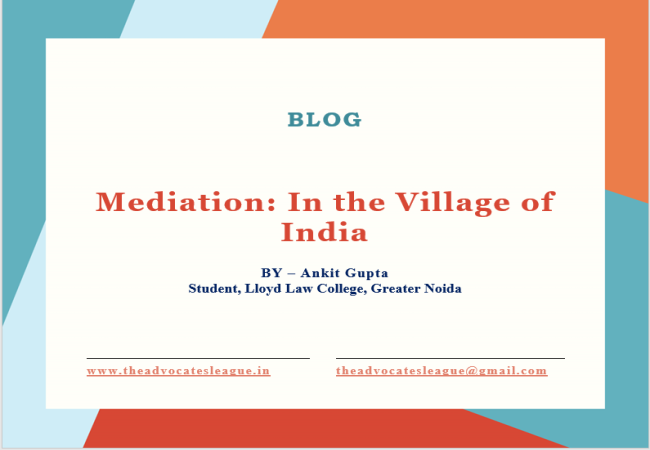Mediation: In the Village of India

Mediation: In the Village of India
INTRODUCTION
Whole civilization has
developed its own ways for resolving disagreements. From ancient times, India
has experienced the informal settlement or resolution of local issues. However,
we found little consistency in conflict resolution processes. There is the one
of the very famous concept that is Panchayat Justice.
Panchayats have played an
essential role in resolving disputes at the rural level since ancient times.
Elders settle conflicts in the community by relying on their personal
relationships with the people and considering local situations, language,
conventions, and practises. The previous system of informal local government
has now been replaced with a formal framework. Mediation, negotiation, and
organized problem resolution are all viable and desirable options for dealing
with conflict and bringing peace to our communities and neighbourhoods.
WHAT
IS MEDIATION?
In India, Mediation is a
deliberate practise in which disputing parties agree to work together to find a
solution to their practical dispute by signing an agreement and choosing a
mediator. The contending parties make the decisions, with the mediator serving
as a buffer to help them reach an agreement. The parties might hire ADR legal
counsellors to represent them in front of the mediator and professionally
explain the issue.
A mediator can be anyone,
with any title, and can be appointed formally or informally, depending on the
desire of the parties. The mediation law has been simplified and made
completely accessible.
MEDIATION
AS PANCHAYATI SYSTEM
Panchayati justice is not
a new concept, but rather an old institution with profound roots in the Indian
culture. The Panchayati Raj system, which combined community development
activities and the Nyaya Panchayats (NP) system for local conflict settlement,
has been a significant innovation since independence. In India, Nyaya
Panchayats have existed since ancient times. NPs were handling conflicts
according to local customs.
The formation of NPs can
be considered as illustrative of two other factors:
i)
At the level of values, their creation
reflected a desire to provide easy legal access to the village population
ii)
At the same time, it represents a massive
attempt by the state to displace existing dispute institutions in village
areas, such as caste institutions,
territorially based secular institutions, or other special initiatives by
social reformers.
The states of Madhya
Pradesh and Uttar Pradesh developed Nyaya Panchayats based on the state policy
Directive Principles. At the time of the constitution's promulgation, several
regions, such as Madras, Mysore, and Kerala, had a system of village courts.
SARPANCH:
A MEDIATOR OF THE VILLAGE
In Indian villages,
people living among them occur in many problems where some are small and some
are big. There conflict arise in the circumstances in competition for land and natural
resources such as water, conflict between the different communities, boundaries
disputes and other various conflict the village faces but at the end of
their mind they want their disputes to be resolved by itself or by some other
person who can help them.
Villages have their Nyaya
Panchayats who is headed by a group of people. It is made up of five wise and
respected village elders. These panchas are elected by members of the Gram
Sabha using a secret ballot system. Among them one person is the village head
is known as Sarpanch. As
the village leader, he resolves customary disputes as a judge of village peace,
which is comparable to "mediation," in which the village head acts as
a neutral person who assists the two parties to the disagreement in the dispute
resolution process through discussion or consensus.
BIRTH
OF ADR
Since the beginning of
time, when there have been Kulas, people have lived in joint families with
members of their clans and a caste system has been a prominent feature of
society. The head of the family, clan, or kula was responsible for settling
disputes among the Kulas. Similar to
this, when there was common trade, corporations, or Shrenis among the people,
they used to appoint individuals to settle disputes within the Shrenis.
Later on, the king (Raja) being a leader of the village
resolve the disputes of their Praja, who
had faith in him as the king was like the god of their citizens. In India,
mediation has long been used as an alternative to municipal courts for
resolving disputes. The Bhradarnayaka Upanishad is the earliest treatise that
is known to exist, and it makes reference to several different kinds of
arbitral bodies, including the Puga, Sreni, and Kula. These tribunals, which
were subsequently called Panchayats, handled a range of conflicts, including
those that were contractual, matrimonial, and even criminal in nature. A
settlement reached as a result of conciliation by the panchayat would be as
binding as a decision that was based on obvious legal obligations because the
parties in dispute would typically accept the panchayat justice.
CONCLUSION
The process of ADR is now been an easy tool for dispute resolution in
the world. Villagers hold the belief that disputes should be settled within the
confines of their own four walls because this was seen as a way to preserve
their reputation and persona in society. People choose an alternative method of
dispute resolution to avoid going through the legal system. They contact
Mukhiya, share their issues with him, and have their dispute settled. This
shows that this mechanism has gained significance in India since ancient times.
People from various places follow this trends as they want their dispute
to be resolved faster this is because they do not want to engage in the fights
and sourness between their neighbours as the village is very confined place and
less area per km, so people try to live happily rather than to fall in
disputive matters.
